Ferepoka glavo

Glavoj faritaj el fero (kontraste al tiuj faritaj el bronzo) aperis el la komenca Ferepoko (ĉ. la 12a jarcento a.K.), sed ili ne disvastiĝis antaŭ la 8a jarcento a.K.
La glavoj de la komenca Ferepoko estis tre diferencaj el postaj ŝtalaj glavoj. Ili estis prilaboritaj por plifortigo, pli ol plifortigitaj per meto en malvarma akvo, kio faris ilin nur ĉirkaŭ la samaj aŭ iomete pli bonaj laŭ terminoj de forto kaj rezistt kompare al la pli fruaj bronzoglavoj. Tio signifas ke ili povis ankoraŭ esti ŝanĝitaj dum la uzado. Tiu tiom plej frua produktado, tamen, kaj la plej granda disponeblo el la kruda materialo ebligis multan pli grandskalan produktadon.
Eventuale forĝistoj lernos ke per aldonado de ia kvanto de karbono (aldonita dum la fandado en la formo de karbo) al la fero, ili povis produkti plibonigitan alojon (nune konata kiel ŝtalo). Per malvarmigo (fari la ŝtalon forta kaj rompebla) kaj kaj hardado (forigi la rompeblon), oni povis fari glavojn kiuj povu suferi multe malpli da damaĝo, kaj povus pli facile reveni al sia formo okaze de misformiĝo. Necesis longa tempo, tamen, antaŭ tio estis farita konsiste, kaj eĉ ĝis la fino de la komenca mezepoka periodo, multaj glavoj estis ankoraŭ faritaj el neplifortigitaj fero. Kelkaj diferencaj metodoj de glavofarado ekzistis en antikvaj epokoj, inklude, plej fame, diverstavolado. Laŭlonge de la historio, diferencaj metodoj estis disvolvigitaj tra la tuta mondo.
Bibliografio
[redakti | redakti fonton]- C. R. Cartwright, Janet Lang, British Iron Age Swords And Scabbards, British Museum Press (2006), ISBN 0-7141-2323-4.
- Andrew Lang, Celtic Sword Blades, in Man, Royal Anthropological Institute of Great Britain and Ireland (1907).
- J. M. de Navarro, The Finds from the Site of La Tène: Volume I: Scabbards and the Swords Found in Them, London: The British Academy, Oxford University Press (1972).
- Radomir Pleiner, The Celtic Sword, Oxford: Clarendon Press (1993).
- Graham Webster, A Late Celtic Sword-Belt with a Ring and Button Found at Coleford, Gloucestershire, Britannia, Society for the Promotion of Roman Studies (1990).
Eksteraj ligiloj
[redakti | redakti fonton]Text is available under the CC BY-SA 4.0 license; additional terms may apply.
Images, videos and audio are available under their respective licenses.
